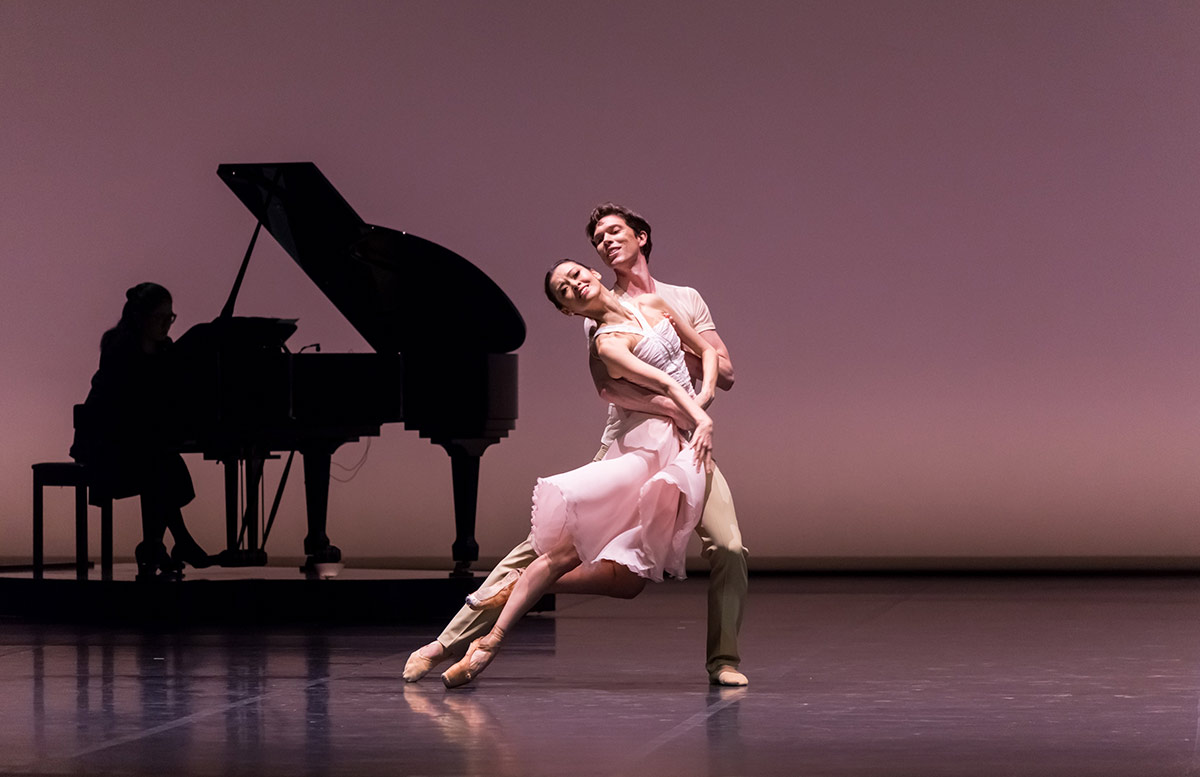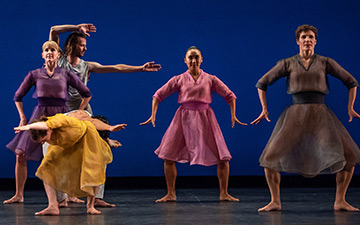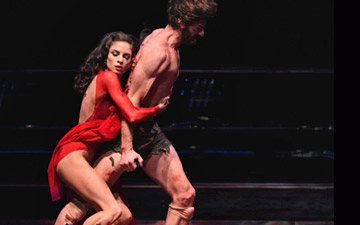
© Askhat Nurekin. (Click image for larger version)
Astana Ballet
Love Fear Loss, A Fuego Lento, Heritage of the Great Steppe, Salomé
★★★✰✰
London, Linbury Theatre
12 September 2019
astanaballet.com
www.roh.org.uk
Information about the Astana Ballet from the Central Asian Republic of Kazakhstan, making its UK debut in the Linbury theatre, is tantalisingly opaque. Presented by Ensemble Productions, its publicity states that it is Kazakhstan’s newest ballet company, founded six years ago. It appears to be distinct from the Astana Opera Ballet, whose artistic director is Altynai Asylmuratova, former leading ballerina of the Mariinsky (ex Kirov) Ballet. Her company is based in the State Theatre of Opera and Ballet in Nur Sultan, the capital formerly known as Astana. It performs the 19th century classics (and Kenneth MacMillan’s Manon), while the Astana Ballet, based in its own new theatre, tours widely with one-act modern ballets and traditional folk-inspired numbers.
Astana Ballet’s resident choreographer and artistic associate is Brazilian Ricarado Amarante, who created the first and last works in the mixed bill. Love Fear Loss, the opening number for six dancers, was first made for the Royal Ballet of Flanders, Amarante’s former company, and has also been danced by Atlanta Ballet. Videos show on an onstage piano that would have been preferable to the over-amplified piano recording used in the Linbury of three tunes associated with Edith Piaf.
The first pas de deux, to Hymne à l’amour, is a display of carefree young love (David Jonathan, Australian, with Dilara Shomayeva). The second, Ne me quiitte pas (Don’t leave me) is needy, clinging duet, committedly danced by Ainur Abilgazina and Ilya Manayenkov. The third, to Mon Dieu, the most impressive with its spectacular lifts, leaves the woman, Tatyana Ten, abandoned at the end as her lover, Farkhad Burieyv, exits. All three pas de deux, choreographically similar, feature ice-skating swirls, slides and high lifts. Each man has only a few bars to show what he can do on his own before gripping his volatile female partner once again.

© Askhat Nurekin. (Click image for larger version)
Amarante’s second offering, A Fuego Lento (Slow Burn), treats the men as dancers in their own right. Set to tango music by Astor Piazolla and Carlos Gardel (and others), it owes a lot to Hans Van Manen’s 5 Tango’s, though it doesn’t stop at just five. The women’s pointe shoes resemble weapons, their legs slashing like flick-knives around their partners’ bodies. The men are as seductive as the women, preening together as a cohort as well as featuring in solos, macho duets and a pas de cinq with a provocative woman. A finale of assembled duets is an effective evocation of a dance hall.
Neither ballet has anything specific to do with Kazakhstan, unlike the central offering in the programme, Heritage of the Great Steppe. It’s a 25-minute collage of Central Asian ethnic dances and choreographic miniatures – an introduction to Kazakh culture in a divertissement form. Elaborately costumed women, stunningly beautiful, glide in formation patterns or prance as acrobatic warriors. There’s a dying swan solo with fluttering arms and another for a joyous bird in green sequins. Intermingled are dancers of both sexes in long black skirts performing oriental and modern dance moves. The conclusion is an epic battle for the Motherland that seems a fragment from a larger work. Though the company tours Heritage of the Great Steppe within Kazakhstan, it looks like an entertainment designed for tourists.
The most substantial piece in the programme is Salomé, created by the company’s chief choreographer, Mukaram Avakhri. Based on Oscar Wilde’s play, it displays the dancers’ considerable dramatic abilities, combining balletic pointe work and contemporary dance to a stirring score by Turkish composer Fazil Say. The action takes place at night, beneath an ominous moon of changeable colours. The set consists of a moveable platform upon which the performers can sit, strut and appear to behead the prophet Jokanaan (John the Baptist). It serves as a table top for Salomé’s infamous dance, with avid spectators gathering around it like those in Béjart’s Bolero.

© Askhat Nurekin. (Click image for larger version)
Avakhri’s staging uses a large cast of party guests and dancing girls attending Herod’s decadent banquet. Both he (Kazbek Akhmedyarov) and his gorgeous wife, Herodias (Riza Kanatkyzy) are dressed in Tyrean purple to indicate their imperial status as they lord it over their guests. The curiosity at the party is the captive prophet, John (Farkhad Bureyev). Although he is lusted after like a rock star, he must remain impassive, an unrewarding role for a fine dancer. Herod’s stepdaughter Salomé (Aizhan Mukatova) does everything she can to arouse him – she couldn’t do more, other than remove her flesh-coloured slip during her dance without seven veils.
Mukatova’s Salomé is a nymphomaniac, a psychotic seducer with hyper-supple limbs. She is given a time-out solo to eerily plucked strings to reveal just how crazed she is, while the chorus of party-goers waits in the darkness behind her. It’s the kind of monologue Yuri Grigorovich introduced in his ballets for the Bolshoi. Since John won’t yield to her, Salomé demands his death as a reward once her erotic dance has further inflamed Herod’s desire for her. She and Herod have been watched jealously by her mother, a commanding figure who deserves more than just a supporting role as a stalker. I think Salomé fantasises that John submits to her in a wonderfully melodramatic sequence in which his head rolls along the upended platform and she then sits on his (unsevered) neck to kiss his lips.
In Wilde’s play, Herod has Salomé killed by his soldiers. In Avakhri’s ballet, according to the synopsis; ‘The feast continues. Flaming salacity is replaced by satiety. There is no joy, no fear, only humility before the irreversibility of the end’. What happens is that Herodias leads the blood-sated party-goers in a line along the platform at the rear: one by one they dive or drop out of sight. Herod is the last man standing as the lights go out.
It’s a powerful piece that needs to be seen on a bigger stage with better lighting (and a better translation of the synopsis). The extremely good-looking company members are well-trained, versatile dancers who must be accustomed to putting up with unpredictable conditions on tour. Let their management not boast that they have appeared on London’s Royal Opera stage: the newly reconfigured Linbury studio theatre is not a fit setting for such a large, ambitious company, packaged to represent Kazakh culture.

















You must be logged in to post a comment.